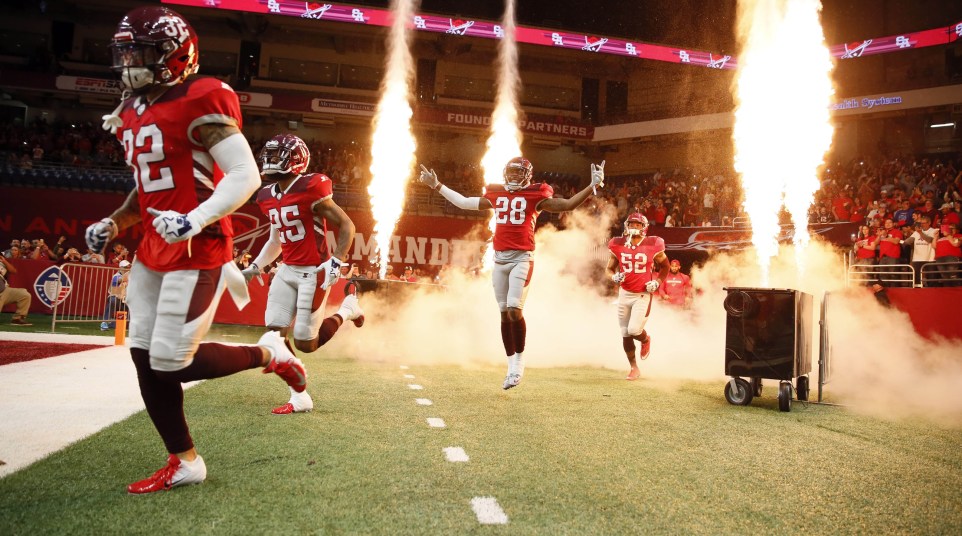
Why you shouldn't jump to negative conclusions about the AAF after the week that was
Let me guess. You’re ready to dismiss the Alliance of American Football as a thing.
You saw the headline earlier in this week about the AAF getting a $250 million investment “to save the league” and you’re now under the impression that it’s in major trouble.
You probably saw some headline like this and thought, “well, that was fun while it lasted.”
Week One for @TheAAF: So far, so good.
Week Two for @TheAAF: We need $250 million right now or it's over! https://t.co/bUvCZs3ofK— ProFootballTalk (@ProFootballTalk) February 19, 2019
Here’s hoping you actually took the time to do more than read a headline.
If you did, you would have read that while the league did get Carolina Hurricanes owner Tom Dundon to step in and invest $250 million, it wasn’t as desperate as the headline suggested. As we found out, one of the league’s initial investors backed out. That meant the startup league needed immediate capital because, believe it or not, not everybody just has an entire payroll worth of money sitting in the bank.
The league had enough money to finish its inaugural season and start next season. The initial investor was counted on to grow the league. For whatever reason, those funds weren’t there.
In stepped Dundon, who according to league co-founder and CEO Charlie Ebersol, was one of several potential investors who showed interest after opening weekend.
“After that first week of games, we were at the height of our valuation and were able to dictate our future,” Ebersol said when asked by the Orlando Sentinel if the league was in a financial bind before Dundon bought in. “We are a start-up, and start-ups usually raise money in pieces — there’s a Series A piece, Series B, Series C, etc. After the success of the first week, we had a number of investors come to us and offer us all kinds of different investments. Tom Dundon showed up and said, ‘Do you want to continue to raise Series B, Series C and Series D or do you want to raise Series Infinity right now and be taken care of from now on?’ That was an offer I was not going to refuse.”
That’s a little bit different than what some might have assumed, which was that the league came so woefully short of meeting expectations that it was in need of $250 million just to survive. As Steve Spurrier told the Orlando Sentinel, “now the future looks very good.”
Confirmation bias set in with plenty of people who saw the “bailout” headline. After all, this is still a startup. Many expect it to fail just like other pro football leagues. We’re not used to seeing news like that with professional sports because duh, they’re already billion-dollar entities with billionaire investors already on board. The AAF is a professional sports business, albeit one that’s in a totally different situation than established pro sports leagues.
In other words, don’t treat the $250 million investment as an ominous sign for the league.

Credit: Soobum Im-USA TODAY Sports
As I said after Week 1, there are still countless personnel/marketing/financial decisions that are going to determine what the AAF becomes.
For now, it’s a spring football league that has potential to fill a need for the NFL. With the NFL Network broadcasting games, the AAF has already accomplished a key feat by garnering NFL interest as a developmental league. That bodes well for the future because if there is a quality product that could need more financial backing down the road, the NFL could come calling.
Obviously there are still questions about the league moving forward. How much local fans are going to embrace AAF teams is a question, and so is how many people watch when a combination of March Madness and playoff NBA/NHL games are on later in the season.
There are other hurdles that need to be overcome, like the league getting workers’ compensation insurance coverage from a Florida-based company so that the Orlando Apollos can actually practice in their home state. It wouldn’t be ideal to have the face of the league, Spurrier, making a long commute to practice because of an insurance technicality. It’s also not ideal for getting midweek press for what could be the league’s top team.
And the ticket pricing, at least from what I’ve seen, could use some improvement. For example, the Apollos have too many lower-level tickets for sale at $100. And from what I’ve seen as an Orlando resident, there aren’t enough local promotions to drive fans in (kids could be half-priced, UCF students could get discounts, etc.)
But am I still somewhat optimistic about the AAF’s prospects even with those early issues? For sure. It’d be strange if a startup professional sports league didn’t have some financial or logistical issues early on.
I’m still of the belief that the product on the field is better than expected, and that ultimately, this showcase is going to lead to NFL opportunities for the league’s best.
If you were all-in on the AAF before the week that was, one ominous headline shouldn’t have changed that belief. If you were in wait-and-see mode before this week and are now completely over the AAF, I’d question that approach, too.
My suggestion? Read more than a headline to make up your mind about something entering its third week of existence.
